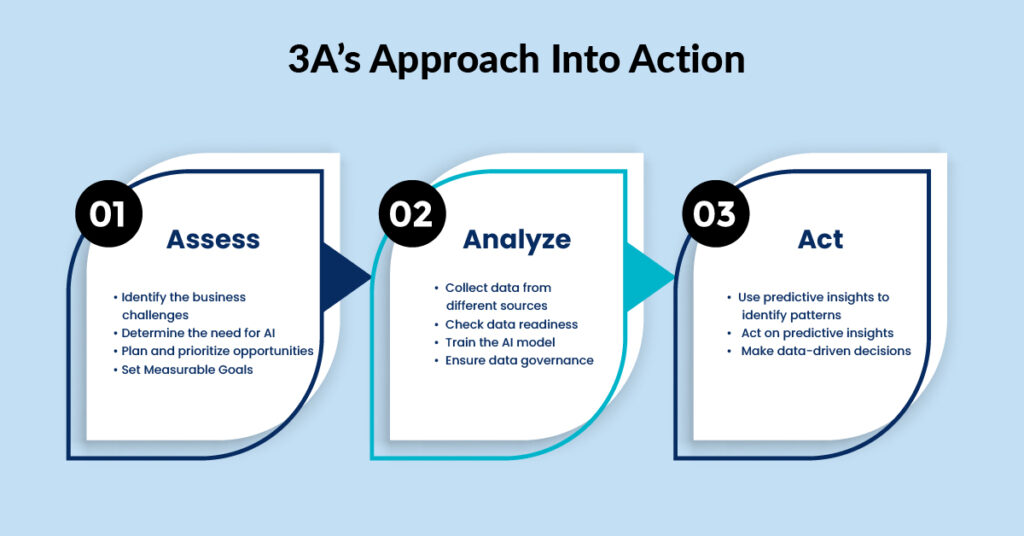Let’s set the record straight—AI in 2025 is indispensable and a critical driver of business transformation. While many enterprises are already tapping into AI’s potential, others are just starting to explore what it can do. If you’re looking to implement AI for your organization, AblyPro ensures the right strategy! With our 3A’s approach—Assess, Analyze, Act—we provide a strategic roadmap to guide every step of your AI implementation journey. We start by assessing the unique needs and challenges of your organization, ensuring AI is the right fit. Next, we analyze opportunities and data insights to shape a tailored strategy. Finally, we act by deploying AI solutions seamlessly, delivering impactful results. This structured process ensures transparency, smooth execution, and measurable success for your organization.
At its core, AI streamlines workflows, optimizes operations, and enhances customer experiences. From a strategic perspective, it’s about analyzing vast datasets to predict risks, personalize engagement, and enable smarter, faster decision-making.
What truly sets your enterprise apart is how AI transforms your organization.
If AI hasn’t yet become your organization’s “Next Big Thing,” the key is getting it right. Is it driving growth and innovation, or just another tool in your tech stack? With a clear AI implementation checklist, we’ll help you make AI a scalable solution that creates real value across your business.
That’s why AblyPro has simplified AI implementation into the 3A’s approach—Assess, Analyze, Act. This ensures AI is tailored to your business needs, unlocking its full potential to address challenges and drive measurable results.
AI Implementation Roadmap: 3A’s Approach Into Action
AI is no longer a distant vision for enterprises but a transformative reality driving innovation and growth. However, diving headfirst into AI without any clear objectives can lead to wasted resources, misaligned efforts, and a lack of measurable progress, ultimately hindering the potential benefits and increasing the risk of failure. That’s where AblyPro’s 3A’s strategy comes in, serving as a structured approach to ensure AI implementation success. This checklist goes beyond the basics, offering a comprehensive framework to address major pitfalls that can hinder a successful AI journey. By assessing your organization’s current state, analyzing data readiness, and acting on insights, it empowers you to unlock AI’s full potential. It ensures your AI initiatives are built on a solid foundation and steer clear of common challenges.

Let’s take a closer look at the checklist.
1. Assess the Need for AI
Before embarking on your AI journey, it’s essential to identify the business challenges and organizational goals that AI can address. This involves pinpointing areas where AI can streamline tasks, resolve pain points, or uncover valuable trends. At AblyPro, we help assess your organization’s specific AI needs, ensuring that the technology aligns with your strategic objectives and addresses real challenges. This focused approach ensures your AI investments target areas with the highest potential for innovation, improvement, and meaningful impact.
Here are the key parameters to evaluate your organization’s AI needs:
i. Identify the Business Challenges
These are key challenges faced by enterprises that can be effectively addressed through the power of AI technology.
- Predicting at-risk customers to prevent churn.
- Identifying specific customer segments and creating strategies to maximize engagement.
- Forecasting customer lifetime value and optimizing marketing strategies
- Creating comprehensive reports to gauge KPIs.
ii. Determine the Need for AI
When implementing AI, it’s essential to focus on transforming challenges into objectives by targeting specific areas where AI can help.
Here are key areas where AI makes a significant impact:
- Reducing operational costs and optimizing resource allocation.
- Enhancing precision and minimizing errors in operations.
- Offering personalized recommendations to elevate user experience.
iii. Plan and Prioritize Opportunities
Based on your assessment, prioritize the area aligning with your overall business objective for AI implementation. Finally, choose the right AI tool not just for your business success, but also to ensure you get the maximum ROI.
Here are some key factors to guide your decision:
- Look for tools that automate processes, streamline workflows and scale with your growth.
- Ensure its cost-effective without compromising quality and delivers reliable results.
iv. Set Measurable Goals
Setting measurable goals is key to ensuring your AI initiatives meet expectations and deliver value. By defining quantifiable targets that align with your business objectives, you create a clear roadmap for success. These goals not only guide decision-making but also provide a basis for tracking progress, evaluating ROI, and ensuring accountability at every stage of implementation. Ultimately, this approach helps AI initiatives contribute to long-term business success and strategic growth.
Here’s how you can do it:
- Improve customer service by 56%
- Enhance employee productivity by 40%
- Manage cybersecurity and fraud by 51%
- Streamline job processes by 53%
Source: 131 AI Statistics and Trends for (2024) | National University
2. Analyze Historical Data
This is a non-negotiable step in the AI implementation checklist. Your data must be as good as the AI tool to prevent “garbage in garbage out”. Make sure that your historical data is clean for accurate insights that drive smart decision-making. AblyPro helps by analyzing data health, cleaning and structuring your data to ensure it is accurate, reliable, and ready to fuel AI-driven insights.
Here’s a glimpse of data analysis:
i. Collect data from different sources
Gather all relevant data to ensure the AI model has the necessary information to make accurate predictions and decisions.
- Identify data sources that include CRM, social media, or financial records.
- Evaluate whether necessary data is available in required quality and quantity.
- Collect raw data from identified sources.
ii. Check Data Readiness
Ensure data is clean, structured and in suitable format for training the AI model.
- Remove inaccuracies, duplicates and irrelevant information from the dataset.
- Create standardized data formats to maintain compatibility across different systems.
- Transform the data to make it usable for the AI model.
iii. Train The AI Model
Teach the AI model to recognize patterns in the data so it can make informed predictions or decisions in the future.
- Use clean and processed data to train the model.
- Feed the data in machine learning algorithms where the model understands patterns and correlations.
- Identify features from the data to detect anomalies or make predictions based on training.
iv. Ensure Data Governance
Your AI implementation must adhere to data governance policy to safeguard data privacy and avoid legal risks.
Here’s how you can protect sensitive information:
- Stay updated on data privacy laws like HIPAA and GDPR.
- Use encryption and access control to avoid potential breaches.
- Get user consent on how you store and use data to avoid potential risks.
3. Act on Recommendations
Implementing AI-driven insights includes translating predictions into actions that drive measurable outcomes. By acting on AI-powered recommendations, your organization can improve processes, meet goals and create areas of improvement.
Here’s how you can do it:
i. Use predictive insights to identify patterns
- Leverage predictive insights to uncover trends and make proactive decisions.
- Use these insights to reshape future business outcomes.
ii. Act on Predictive Insights
- Tailor AI recommendations for specific departments or use cases.
- Adjust actions based on feedback and changing priorities.
iii. Make data-driven decisions
- Drive data-driven decisions leveraging predictive analytics.
- Mitigate uncertainties with informed decisions.
- Use real-time updates to refine decisions and adjust strategies accordingly.
AblyPro, the Ideal Partner for AI Success Using 3A’s Strategy
Now that you have the checklist in hand, the right partner ensures a seamless AI implementation journey. AblyPro understands your unique business needs and tailors 3A’s strategy to deliver maximum value. From assessing your systems to optimizing data, selecting the right tools, and managing change, AblyPro keeps every step on track. They guide your team through complexities, provide expert support, and ensure smooth adoption. With AblyPro, you’re not just implementing AI – you’re transforming your business for the future.
Want to learn more about our 3A’s of AI implementation? Let’s connect and explore how we can drive AI success together!
People may also ask:
- AI for Marketing Department
- AI for Sales Department
- AI for Project Management/Delivery Department
- AI for Customer Service Department
- AI for Finance Department
Author

Global COO, AblyPro

For 20 years, Neeraj has worked alongside a multitalented team to help associations and nonprofits drive digital transformation within their organization, enabling them to be more innovative, agile, and donor/member-centric. As AblyPro’s Global COO, he leads an internal task force that shares lessons learned, best practices, and practical applications that specifically relate to associations and nonprofits. With 300+ developers by his side, Neeraj provides clients with the resources and capacity to power up their teams.





